牛津英语初一英语语法专题讲解
- 格式:doc
- 大小:61.00 KB
- 文档页数:10
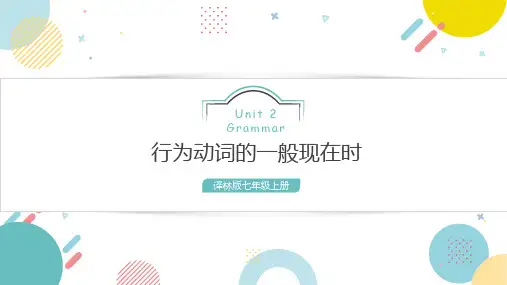
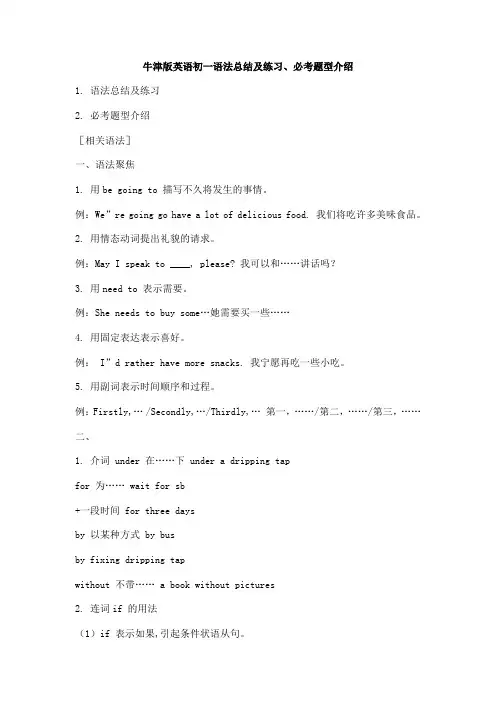
牛津版英语初一语法总结及练习、必考题型介绍1. 语法总结及练习2. 必考题型介绍[相关语法]一、语法聚焦1. 用be going to 描写不久将发生的事情。
例:We”re going go have a lot of delicious food. 我们将吃许多美味食品。
2. 用情态动词提出礼貌的请求。
例:May I speak to ____, please? 我可以和……讲话吗?3. 用need to 表示需要。
例:She needs to buy some…她需要买一些……4. 用固定表达表示喜好。
例:I”d rather have more snacks. 我宁愿再吃一些小吃。
5. 用副词表示时间顺序和过程。
例:Firstly,… /Secondly,…/Thirdly,… 第一,……/第二,……/第三,……二、1. 介词 under 在……下 under a dripping tapfor 为…… wait for sb+一段时间 for three daysby 以某种方式 by busby fixing dripping tapwithout 不带…… a book without pictures2. 连词if 的用法(1)if 表示如果,引起条件状语从句。
(2)if 引起的从句如果是一般现在时,那么主句会是将来时,祈使句或含情态动词。
eg: If there is no rain ,there will be no water to drink.Don”t watch too much television if something is wrong with your eyes.If he comes, you can go.3. 祈使句(1)表示命令或请求。
Come here.(2)祈使句中动词用原形。
Let”s go .(3)分类Don” run downstairs.Let”s go to school by bus.Give me an apple ,please.三、1. When的用法(1)用作特殊疑问词,对时间段或点进行提问(什么时候)在对时间点提问时与what time可以替换:We get to school at six.When(What time) do you get to school?(2)连词when 当……时主句是情态动词,从句用一般现在时。
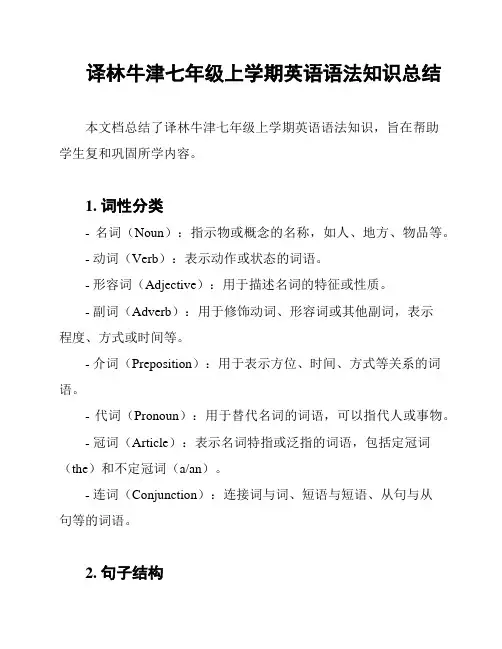
译林牛津七年级上学期英语语法知识总结本文档总结了译林牛津七年级上学期英语语法知识,旨在帮助学生复和巩固所学内容。
1. 词性分类- 名词(Noun):指示物或概念的名称,如人、地方、物品等。
- 动词(Verb):表示动作或状态的词语。
- 形容词(Adjective):用于描述名词的特征或性质。
- 副词(Adverb):用于修饰动词、形容词或其他副词,表示程度、方式或时间等。
- 介词(Preposition):用于表示方位、时间、方式等关系的词语。
- 代词(Pronoun):用于替代名词的词语,可以指代人或事物。
- 冠词(Article):表示名词特指或泛指的词语,包括定冠词(the)和不定冠词(a/an)。
- 连词(Conjunction):连接词与词、短语与短语、从句与从句等的词语。
2. 句子结构- 主语(Subject):句子中进行动作或被描述的人、事物或概念。
- 谓语(Predicate):句子中表达动作或状态的部分,通常是动词。
- 宾语(Object):动作的承受者或受益者,是动词的补充部分。
- 定语(Attributive):用于修饰名词或代词的形容词、副词等。
- 状语(Adverbial):修饰动词或整个句子的副词、介词短语等。
3. 时态与语态- 时态(Tense):表示动作发生的时间,如一般现在时、过去时、将来时等。
- 语态(Voice):表示动作的主体和动作所受的影响关系,如主动语态和被动语态。
4. 句型结构- 简单句(Simple Sentence):只包含一个主语和一个谓语的句子。
- 并列句(Coordination Sentence):由并列连词连接的两个或多个简单句。
- 疑问句(Question Sentence):用于提问的句子,通常以疑问词开头或动词倒装。
以上是关于译林牛津七年级上学期英语语法知识的简要总结。
希望这份文档能够帮助你更好地复习和应用所学的语法知识。
祝你学习进步!。
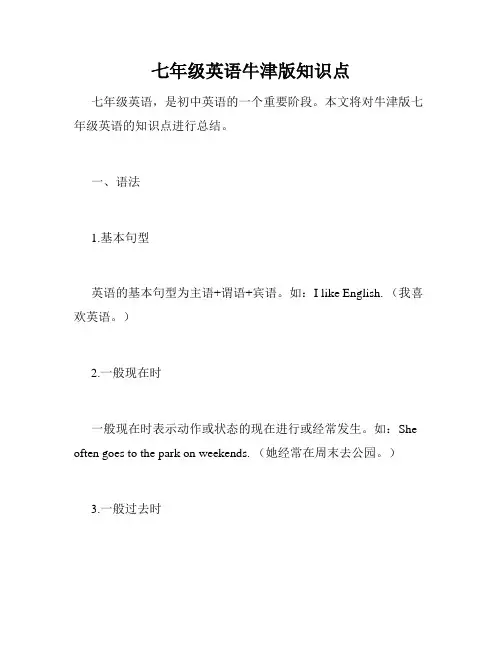
七年级英语牛津版知识点七年级英语,是初中英语的一个重要阶段。
本文将对牛津版七年级英语的知识点进行总结。
一、语法1.基本句型英语的基本句型为主语+谓语+宾语。
如:I like English. (我喜欢英语。
)2.一般现在时一般现在时表示动作或状态的现在进行或经常发生。
如:She often goes to the park on weekends. (她经常在周末去公园。
)3.一般过去时一般过去时表示过去某一时间发生的动作或状态。
如:He watched TV last night. (他昨晚看了电视。
)4.一般将来时一般将来时表示将来某一时间要发生的动作或状态。
如:I will visit my grandparents next week. (我下周会去看望我的祖父母。
)5.情态动词情态动词可以表示说话人的心情、意愿或能力等。
如:We can play basketball together. (我们可以一起打篮球。
)二、词汇1.日常生活用语学生可以学习一些日常生活用语,如问候语、询问时间、询问地址等。
如:How are you? (你好吗?)2.数字在初中英语中,学生需要学习如何用英语说和写数字。
如:twenty-three (23)3.颜色初中英语中也需要学习颜色的表达。
如:green (绿色)三、阅读理解在初中英语中,阅读理解是一个重要的环节。
学生需要阅读各种文章,从中获取信息并回答相关问题。
1.阅读短文学生可以阅读各种长度的短文,从中获取信息并进行理解。
如:Hello, my name is Mary. I live in New York with my family. I have a cat named Ginger. He is very cute. I like to play with him.2.问答题问答题是英语阅读理解中的一个重要环节。
学生需要根据文章提出的问题,回答相关问题。

七年级牛津英语知识点汇总在这篇文章中,我们将对七年级牛津英语的知识点进行全面汇总,帮助同学们更好地掌握这门语言。
以下是知识点的详细介绍。
1. 基本语法规则英语的基本语法规则包括主谓宾结构、时态、语态等。
其中主谓宾结构是英语语句的基本构成形式,主语通常在句子的开头,接着是动词,最后是宾语。
时态主要分为一般现在时、一般过去时和一般将来时等。
语态则包括主动语态和被动语态。
2. 词汇积累词汇是语言的基础,掌握了足够的词汇量,才能更好地进行语言表达。
同学们需要学习常用的单词、词组和常见短语,并进行实践运用。
3. 阅读技巧阅读是英语学习的重要环节,同学们需要学习阅读技巧,包括扫读、略读和精读等,以更好地理解文本内容。
4. 写作技巧写作是英语学习的另一重要环节,同学们需要学习写作技巧,包括如何构思、如何组织文章、如何使用词汇等。
此外,还需多进行写作练习,不断提升语言表达能力。
5. 听力技巧英语听力是与外国人交流的重要途径,同学们需要学习听力技巧,包括如何处理语速、重音和语调等问题,以更好地理解说话者的意图。
6. 口语表达口语是英语学习的最终目标,同学们需要积极锻炼口语表达能力,多进行口语练习,提高说话的流畅性和准确性。
7. 文化知识英语是一门世界性语言,同学们需要了解英语国家的文化习惯、社会背景等知识,这有助于更好地理解英语的使用规范和语境。
以上就是七年级牛津英语的知识点汇总。
同学们需要通过实践和不断的学习,掌握这些知识点,提高自己的语言水平。
祝愿大家在英语学习道路上越走越远!。
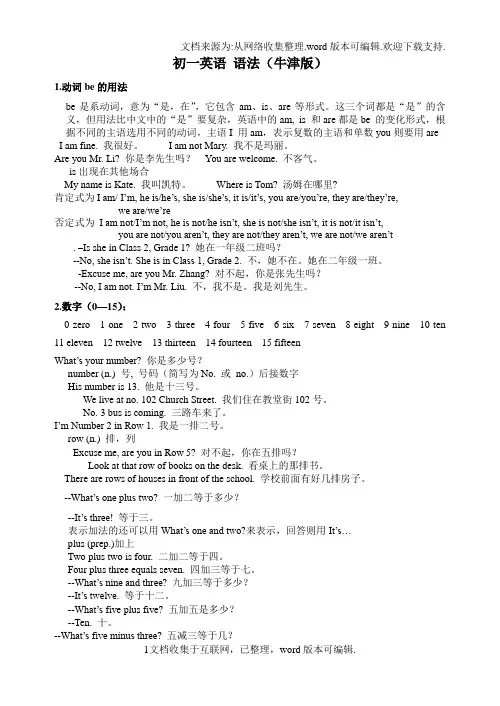
初一英语语法(牛津版)1.动词be的用法be是系动词,意为“是,在”,它包含am、is、are等形式。
这三个词都是“是”的含义,但用法比中文中的“是”要复杂,英语中的am, is 和are都是be 的变化形式,根据不同的主语选用不同的动词,主语I 用am,表示复数的主语和单数you则要用are I am fine. 我很好。
I am not Mary. 我不是玛丽。
Are you Mr. Li? 你是李先生吗?You are welcome. 不客气。
is出现在其他场合My name is Kate. 我叫凯特。
Where is Tom? 汤姆在哪里?肯定式为I am/ I’m, he is/he’s, she is/she’s, it is/it’s, you are/you’re, they are/they’re,we are/we’re否定式为I am not/I’m not, he is not/he isn’t, she is not/she isn’t, it is not/it isn’t,you are not/you aren’t, they are not/they aren’t, we are not/we aren’t . –Is she in Class 2, Grade 1? 她在一年级二班吗?--No, she isn’t. She is in Class 1, Grade 2. 不,她不在。
她在二年级一班。
-Excuse me, are you Mr. Zhang? 对不起,你是张先生吗?--No, I am not. I’m Mr. Liu. 不,我不是。
我是刘先生。
2.数字(0—15):0 zero 1 one 2 two 3 three 4 four 5 five 6 six 7 seven 8 eight 9 nine 10 ten 11 eleven 12 twelve 13 thirteen 14 fourteen 15 fifteenWhat’s your number? 你是多少号?number (n.) 号, 号码(简写为No. 或no.)后接数字His number is 13. 他是十三号。
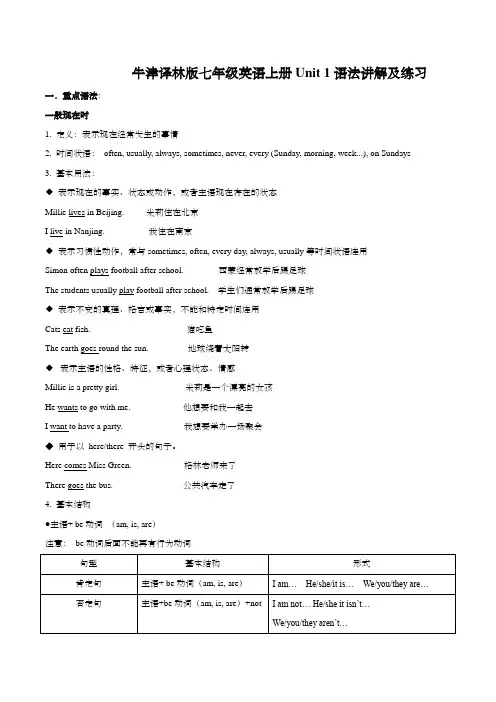
牛津译林版七年级英语上册Unit 1语法讲解及练习一.重点语法:一般现在时1. 定义:表示现在经常发生的事情2. 时间状语:often, usually, always, sometimes, never, every (Sunday, morning, week...), on Sundays3. 基本用法:◆表示现在的事实、状态或动作,或者主语现在存在的状态Millie lives in Beijing. 米莉住在北京I live in Nanjing. 我住在南京◆表示习惯性动作,常与sometimes, often, every day, always, usually等时间状语连用Simon often plays football after school. 西蒙经常放学后踢足球The students usually play football after school. 学生们通常放学后踢足球◆表示不变的真理、格言或事实,不能和特定时间连用Cats eat fish. 猫吃鱼The earth goes round the sun. 地球绕着太阳转◆表示主语的性格、特征,或者心理状态、情感Millie is a pretty girl. 米莉是一个漂亮的女孩He wants to go with me. 他想要和我一起去I want to have a party. 我想要举办一场聚会◆用于以here/there 开头的句子。
Here comes Miss Green. 格林老师来了There goes the bus. 公共汽车走了4. 基本结构●主语+ be动词(am, is, are)注意:be动词后面不能再有行为动词be动词(am, is, are)的使用:1. We use ‘am’ when the subject is _I____ .2. We use ‘are’ when the subject is _we ___, _ you __ or ___they __ .3. We use ‘is’ w hen the subject is __he __, __she or __ it ___ . be动词的使用口诀:我用am,你用are, is连着他、她、它,单数形式用is, 复数形式要用are●主语+ 行为动词行为动词的第三人称单数形式的变化规律:1、直接在词尾加s如:look-looks play-plays2、以辅音字母加y结尾, 去y为i加es如:fly-flies study-studiestry-tries carry-carries3、以sh、ch、s、x、o结尾加es如:guess-guesses wash—washescatch-catches mix-mixesgo-goes do-does★ have的第三人称单数形式是has二.语音知识:(见教材)三.随堂练习-----语法专练用相应的be动词填空1. I an English teacher.2. Sandy from China.3. He polite.4. We in Class 3, Grade 7.5. Mrs Fang and Mr Liu doctors.6. The girls in the classroom.7. Our football team the best in the city.8. Mr. Li our Maths teacher.9. Simon a member of the Reading Club?10. Simon and Millie friends?选择填空:( )1. —What ______ your uncle? —He’s a policeman.A. isB. areC. doD. does( )2. The girl doesn’t like the skirt ______ red flowers.A. haveB. hasC. withD. and( )3. It is going to rain. He must ______now .A. runs to homeB. run to homeC. runs homeD. run home ( ) 4.Do you often go in summer ?A.swimB.swimsC.swimingD.swimming ( ) 5.I usually go in the morning.A.runB.runsC.runingD.running ( ) 6.Simon with his friends football on Tuesday afternoon.A.playB.playsC.play theD.plays the ( )7.Sam his homework at school.A.do esn’tB.doesn’t doC.don’t doD.doesn’t does ( )8.After he breakfast, he always his dog for a walk.A.have / takesB.has / takeC.haves / takesD.has / takes 用所给动词的适当形式填空1.Daniel (wear) a pair of glasses.2.There are six (fish) in the bag.3.Alice (study) English at school.4.I always go (run) in the morning.5.She (go) to work by bike every day.6.Sometimes Sandy (fly) a kite at weekends.7.My father often (watch) TV in the evening.8.His mother usually (wash) the clothes on Sundays.9.We often have dinner at my (grandparents) home.10.He enjoys .He often goes in the (swim) pool.11. __________your aunts good at __________ (make) cakes?12. He __________ (not like) __________ (drink) milk.13. How __________ (be) your grandfather?14. My little cat really __________ (want) __________ (eat) fish.15. He __________ (not know) where __________ (sit).16. Each of us can __________ (sing) an English song.17. Who __________ (bring) the dog here?18. There are lots of things for ________ (he) ________ (do) now.19. Our teacher always __________ (say) every student can ________ (be) very good.20. ________(not late) for school next time.句型转换:1.I do my homework in the evening. (改为否定句)I my homework in the evening.2.He does his homework at home.(改为一般疑问句,并作肯定回答)he his homework at home ? , he .3.They play football after school .(对画线部分提问)they football ?4.She goes to school by bus .(对画线部分提问)she to school ?。
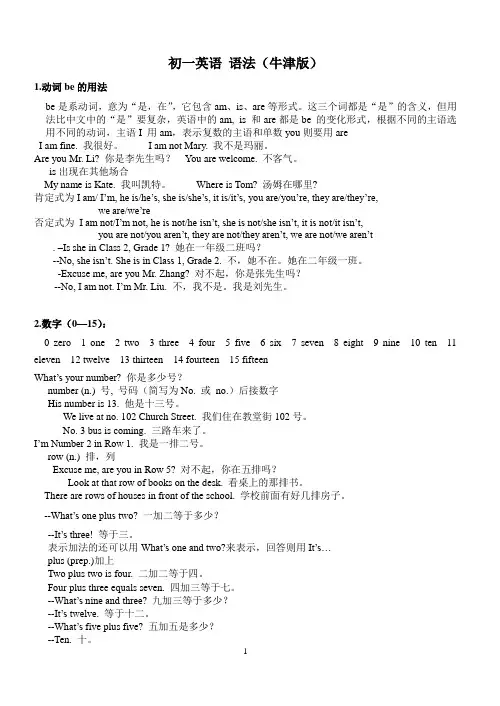
初一英语语法(牛津版)1.动词be的用法be是系动词,意为“是,在”,它包含am、is、are等形式。
这三个词都是“是”的含义,但用法比中文中的“是”要复杂,英语中的am, is 和are都是be 的变化形式,根据不同的主语选用不同的动词,主语I 用am,表示复数的主语和单数you则要用areI am fine. 我很好。
I am not Mary. 我不是玛丽。
Are you Mr. Li? 你是李先生吗?You are welcome. 不客气。
is出现在其他场合My name is Kate. 我叫凯特。
Where is Tom? 汤姆在哪里?肯定式为I am/ I’m, he is/he’s, she is/she’s, it is/it’s, you are/you’re, they are/they’re,we are/we’re否定式为I am not/I’m not, he is not/he isn’t, she is not/she isn’t, it is not/it isn’t,you are not/you aren’t, they are not/they aren’t, we are not/we aren’t . –Is she in Class 2, Grade 1? 她在一年级二班吗?--No, she isn’t. She is in Class 1, Grade 2. 不,她不在。
她在二年级一班。
-Excuse me, are you Mr. Zhang? 对不起,你是张先生吗?--No, I am not. I’m Mr. Liu. 不,我不是。
我是刘先生。
2.数字(0—15):0 zero 1 one 2 two 3 three 4 four 5 five 6 six 7 seven 8 eight 9 nine 10 ten 11 eleven 12 twelve 13 thirteen 14 fourteen 15 fifteenWhat’s your number? 你是多少号?number (n.) 号, 号码(简写为No. 或no.)后接数字His number is 13. 他是十三号。
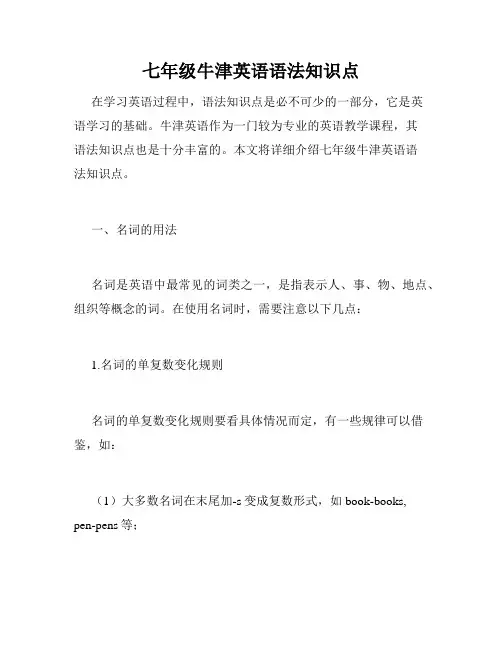
七年级牛津英语语法知识点在学习英语过程中,语法知识点是必不可少的一部分,它是英语学习的基础。
牛津英语作为一门较为专业的英语教学课程,其语法知识点也是十分丰富的。
本文将详细介绍七年级牛津英语语法知识点。
一、名词的用法名词是英语中最常见的词类之一,是指表示人、事、物、地点、组织等概念的词。
在使用名词时,需要注意以下几点:1.名词的单复数变化规则名词的单复数变化规则要看具体情况而定,有一些规律可以借鉴,如:(1)大多数名词在末尾加-s变成复数形式,如book-books,pen-pens等;(2)以x、s、sh、ch结尾的名词在末尾加-es变成复数形式,如box-boxes, bus-buses等;(3)以f、fe结尾的名词通常将f、fe改成ves变成复数形式,如leaf-leaves, knife-knives等;(4)有些名词是不规则的,如man-men, foot-feet等。
2.名词的所有格形式表示“某人的或某物的部分或全部”时,通常要使用名词的所有格形式。
其构成方法如下:(1)如果名词是单数,一般在末尾加‘s表示所有格形式,如Tom’s book;(2)如果名词是复数,且末尾已经是-s,则只需在末尾加一个撇号(’)表示所有格形式,如the boys’ school;(3)如果名词是复数,但不以-s结尾,则在末尾加‘s构成所有格形式,如the children’s toys。
二、代词的用法代词是指代其他名词、代表某些特定的人或事物的词。
在使用代词时,需要注意以下几点:1.代词的种类代词可以分为人称代词(如I、you、he、she、it、we、they)、指示代词(如this、that、these、those)、不定代词(如some、any、no、every、each、few、many、several等)以及相对代词(如who、whom、whose、which、that等)等。
2.代词的使用方法在使用代词时,需要根据具体语境来决定使用哪种代词。
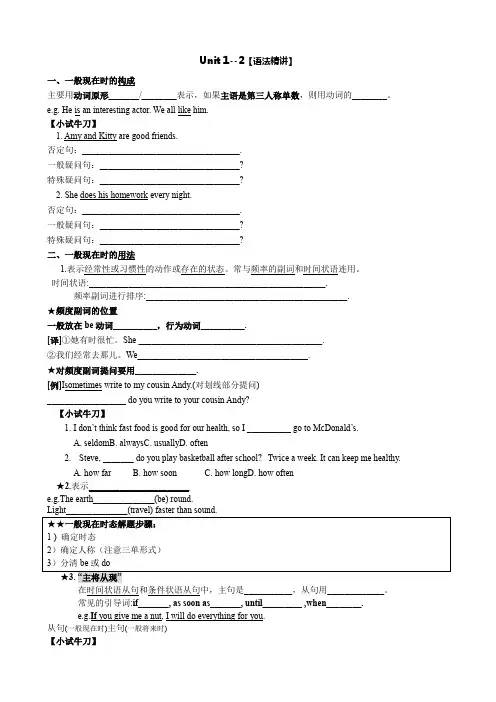
Unit 1--2【语法精讲】一、一般现在时的构成主要用动词原形_______/________表示,如果主语是第三人称单数,则用动词的________。
e.g. He is an interesting actor. We all like him.【小试牛刀】1. Amy and Kitty are good friends.否定句:____________________________________.一般疑问句:________________________________?特殊疑问句:________________________________?2. She does his homework every night.否定句:____________________________________.一般疑问句:________________________________?特殊疑问句:________________________________?二、一般现在时的用法1.表示经常性或习惯性的动作或存在的状态。
常与频率的副词和时间状语连用。
时间状语:______________________________________________________.频率副词进行排序:______________________________________________.★频度副词的位置一般放在be动词__________,行为动词__________.[译]①她有时很忙。
She __________________________________________.②我们经常去那儿。
We_______________________________________.★对频度副词提问要用______________.[例]Isometimes write to my cousin Andy.(对划线部分提问)__________________ do you write to your cousin Andy?【小试牛刀】1. I don’t think fast food is good for our health, so I __________ go to McDonald’s.A. seldomB. alwaysC. usuallyD. often2. --Steve, _______ do you play basketball after school?--Twice a week. It can keep me healthy.A. how farB. how soonC. how longD. how often★2.表示_______________________e.g.The earth______________(be) round.在时间状语从句和条件状语从句中,主句是___________,从句用_____________。
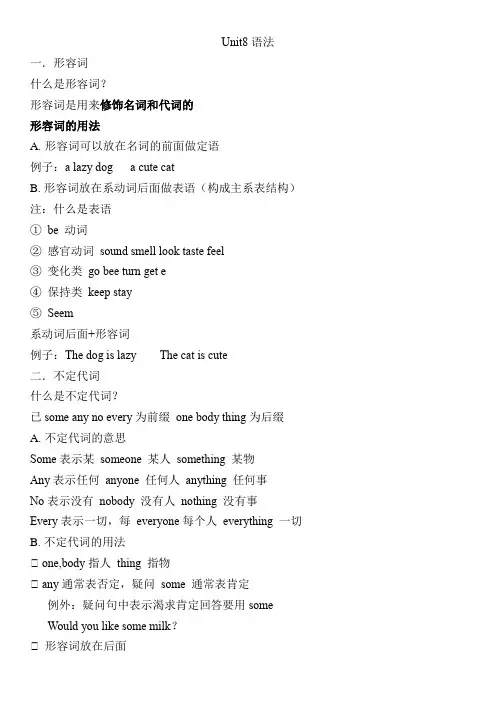
Unit8语法一.形容词什么是形容词?形容词是用来修饰名词和代词的形容词的用法A.形容词可以放在名词的前面做定语例子:a lazy dog a cute catB.形容词放在系动词后面做表语(构成主系表结构)注:什么是表语①be 动词②感官动词sound smell look taste feel③变化类go bee turn get e④保持类keep stay⑤Seem系动词后面+形容词例子:The dog is lazy The cat is cute二.不定代词什么是不定代词?已some any no every为前缀one body thing为后缀A.不定代词的意思Some表示某someone 某人something 某物Any表示任何anyone 任何人anything 任何事No表示没有nobody 没有人nothing 没有事Every表示一切,每everyone每个人everything 一切B.不定代词的用法① one,body指人thing 指物① any通常表否定,疑问some 通常表肯定例外:疑问句中表示渴求肯定回答要用someWould you like some milk?① 形容词放在后面① 后面+三单练习:1. Who helped Jessie with her English?__________. She taught herself.A. AnybodyB. SomebodyC. NobodyD. Everybody2. I think drinking milk every morning is good our health.Yes. I agree __________ you.A. to; toB. with; toC. at; withD. for; with3. May I have a talk with you, sir? I’ve got __________ important to tell you.A. nothingB. anythingC. somethingD. everything4. I __________ here today? Yes, Miss Wu. __________ is away.A. anybody; SomebodyB. everybody; SomebodyC. somebody; AnybodyD. everybody; Nobody5. Peter, what if your parents go out?They ask me to __________ myself.A. look forB. look atC. look afterD. look up6. Money is not ____________. There is still __________ else important for us.A. anything; somethingB. everything; somethingC. something; anythingD. everything; anything7. Do you have __________ else to say for your mistake (错误)?__________ but sorry.A. anything; SomethingB. something; EverythingC. something; AnythingD. anything; Nothing8. Is __________ in the room?Yes,here is Lucy.A. anyoneB. everyoneC. someoneD. no one9. Mum, my American friend Jack will e to dinner this evening.OK. Let's give him __________ to eat.A. everything differentB. different everythingC. different somethingD. something different10. Why are you so ___________, Millie?I thought I lost my mobile phone, but I didn’t. I found it in my bedroom!A. sadB. excitingC. happyD. worried11. When the Browns moved into the house last month, ____________ was at sixes andsevens, so they did a big cleaning.A. anythingB. everythingC. somethingD. nothing12. How are you getting along with your English study?Much better. I don't feel it as __________ as before.A. interestingB. muchC. difficultD. easy。
译林版牛津英语七年级下册全册Unites1-8单元知识点及语法归纳一、重点词组、句型1、Would you like to live in the palace, Eddie? 埃迪,你想住宫殿里吗?①Would you like sth? 肯定答复: Yes, please. 否认答复: No, thanks.②Would you like to do sth? 肯定答复:Yes, I’d like/love to. 否认答复:I’d like/love to, but…2、There are twenty restaurants in town. 镇上有二十家餐馆。
There are about 8,000,000 people living in London. 大约有八百万人住在伦敦。
①表示某地有……,用there be 句型,谓语动词就近原那么。
There __________(be) an art room, a music room and two puter rooms in our school.②表示有事情要做,用there be sth to do。
Thereare lots of things ___________(see) in Beijing..③表示有某人正在做某事,用there be sb doingsth.。
On game shows, there are always famouspeople___________(talk) about their lives.3、I live in a town 15 miles from London. 我住在离伦敦15英里的一个镇上。
be far (away) from 离……远,但出现详细间隔时,不用farMy home is __________________from the school.My home is 5 kilometres ___________from the school.A. awayB. farC. closeD. next to4. have fun with sb./sth. 和某人/某物玩得开心have fun doing sth. 做某事很开心have(has/had) fun= have(has/had) a good time=enjo y(enjoyed) onself(myself/yourself/youselves……)5、I also have a bedroom of my own. =I also havemy own bedroom. 我也有自己的房间。
一、基本语法知识:1.句子和句子成分:-句子由主语和谓语组成,主语通常是一个名词或代词,谓语是一个动词。
-一个句子可以包含其他成分,如宾语、定语、状语等。
2.名词:-名词可以指人、物、地方、动物等。
-名词有单数和复数形式,一般情况下,单数名词加-s来表示复数。
- 名词还有可数和不可数之分,可数名词可以用a或an来修饰,不可数名词通常不加冠词。
3.形容词:-形容词用来描述名词的特征或特性。
-形容词有比较级和最高级,比较级用于比较两个人或物的不同,最高级用于三个或三个以上的人或物的比较。
4.代词:- 代词用来代替名词,如主格代词(I、you、he/she/it等)、宾格代词(me、you、him/her/it等)、物主代词(my、your、his/her/its 等)等。
5.动词:-动词用来表示动作或状态。
-动词有时态的变化,如现在时(一般现在时、现在进行时)、过去时(一般过去时)等。
-动词有人称的变化,如第三人称单数动词在一般现在时加-s。
6.副词:-副词用来修饰动词、形容词或其他副词,表示时间、地点、方式等。
-副词有比较级和最高级。
7.介词:-介词用来表示时间、地点、方向、目的等关系。
- 常用的介词有at、in、on、by、about、for等。
8.冠词:-冠词用来限定名词的范围,分为定冠词和不定冠词。
- 定冠词是"the",不定冠词是"a"或"an"。
9.祈使句:-祈使句用来表示请求、建议、命令等,一般省略主语,动词用原形。
二、词汇:1.常用动词:- be(am、is、are)、have、do、go、get、like、want、see、make、eat、drink等。
2.与家庭有关的词汇:- family、mother、father、brother、sister、grandfather、grandmother、uncle、aunt等。
牛津英语7B unit2语法\'no\'and\'none\'no 1.通常只用作形容词,后面必须跟名词,意思相当于not a (an)或者not any。
2.不能和另一个限定词(冠词、物主代词或者指示词)连用。
否则应该用none of。
1.I can\'t get there----there\'s no bus.2.There were no letters for this morning.3.No teachers were there, either.none1.通常用作代词,后面无需加名词,意思相当于no +名词。
2.none of…的意思是not any of…。
当其用于句首时,如果none指代的是可数名词,那么后面的谓语动词既可以用单数,也可以用复数。
1.There is no milk in this bottle, and there is none in that bottle, either.2.I like none of the food.3.None of my friends live(s) near here.实战演练:根据句意,选用no或none填空。
1. ______ students are in the classroom and there is _____ teacher in it ,either.2. ---- Are there any books on the desk?---- No, there are ________.3. Sorry I can\'t stop---- I have ______ time.4. I\'ve read _______ of these books.5. ______ of them came in time (按时).6. She had ______ idea what I meant.7. The sign means \'_______ smoking here\'.8. I like _______ of the food. It tastes sour.The definite article \' the \'定冠词the主要和名词连用,表示某个或某些特定的人或者东西。
牛津译林版七年级英语上册units1-4单元语法讲解一.一般现在时中be 动词的使用(一)be 动词:动词be (am, is, are)说明身份、年龄、状态等I am a teacher.I am 21 years old.I' m very healthy.(二)be 动词的人称变化:第一人称I,后面的动词用am;第三人称he/she/it, 后面的动词用is;第一人称复数we,第二人称you,第三人称复数they,后面的动词用are.(三)be 动词在一般疑问句和否定句中的表达:--- Are you the student from Class Two?--- No, I'm not.--- Is he Canadian?--- No, he isn' t.--- Are they fond of pop music?--- No, they aren 't.从上面例句中可看出,动词be 一般现在时的一般疑问句,把be 提到句首,它的否定句式是在be 后直接加not 。
(四)be 动词的具体使用:1.be + 形容词I'm very tired.He is handsome and smart.2. be + 名词Mike is a Canadian teacher.They are my close friends.3. be + 介词短语The flowers are in the vase.She is at home now.4. be + 形容词短语My holiday is always long enough.They are tired and hot.5. be +副词I'm home.They are abroad.6. 用于表示时间:Today is Sunday.The next match will be at 7.二•一般现在时中行为动词的使用1. 一般现在时:用于谈论我们经常做的事;目前的状态;目前的爱好、能力;客观事实;真理。
初一英语语法(牛津版)1.动词be的用法be是系动词,意为“是,在”,它包含am、is、are等形式。
这三个词都是“是”的含义,但用法比中文中的“是”要复杂,英语中的am, is 和are都是be 的变化形式,根据不同的主语选用不同的动词,主语I 用am,表示复数的主语和单数you则要用are I am fine. 我很好。
I am not Mary. 我不是玛丽。
Are you Mr. Li? 你是李先生吗?You are welcome. 不客气。
is出现在其他场合My name is Kate. 我叫凯特。
Where is Tom? 汤姆在哪里?肯定式为I am/ I’m, he is/he’s, she is/she’s, it is/it’s, you are/you’re, they are/they’re,we are/we’re否定式为I am not/I’m not, he is not/he isn’t, she is not/she isn’t, it is not/it isn’t,you are not/you aren’t, they are not/they aren’t, we are not/we aren’t . –Is she in Class 2, Grade 1? 她在一年级二班吗?--No, she isn’t. She is in Class 1, Grade 2. 不,她不在。
她在二年级一班。
-Excuse me, are you Mr. Zhang? 对不起,你是张先生吗?--No, I am not. I’m Mr. Liu. 不,我不是。
我是刘先生。
2.数字(0—15):0 zero 1 one 2 two 3 three 4 four 5 five 6 six 7 seven 8 eight 9 nine 10 ten 11 eleven 12 twelve 13 thirteen 14 fourteen 15 fifteenWhat’s your number? 你是多少号?number (n.) 号, 号码(简写为No. 或no.)后接数字His number is 13. 他是十三号。
We live at no. 102 Church Street. 我们住在教堂街102号。
No. 3 bus is coming. 三路车来了。
I’m Number 2 in Row 1. 我是一排二号。
row (n.) 排,列Excuse me, are you in Row 5? 对不起,你在五排吗?Look at that row of books on the desk. 看桌上的那排书。
There are rows of houses in front of the school. 学校前面有好几排房子。
--What’s one plus two? 一加二等于多少?--It’s three! 等于三。
表示加法的还可以用What’s one and two?来表示,回答则用It’s…plus (prep.)加上Two plus two is four. 二加二等于四。
Four plus three equals seven. 四加三等于七。
--What’s nine and three? 九加三等于多少?--It’s twelve. 等于十二。
--What’s five plus five? 五加五是多少?--Ten. 十。
--What’s five minus three? 五减三等于几?--It’s two. 等于二。
minus (prep.) 减去Twelve minus seven leaves five. 十二减去七剩五。
Nine minus three is six. 九减三等于六。
指示代词this、that、it的用法:(1)this 和that用做指示代词,有“这个,这,那个,那”的意思。
This指离说话人较近的一个人或物,that则指较远的一个人或物。
在句中常做主语或定语。
如:this is my pencil. 这是我的铅笔。
(this做主语)this pencil is nice 这支铅笔很漂亮。
(2)it做主语,指前面已经提到的人或事物。
It常在句中代替this 或that。
如:What’s this/that? 这/那是什么? It’s a cake. 是一块蛋糕。
(3)this is 不能略写为this’s。
人称代词(he, she, it)的用法:他he她she它it,其后be动词用is他的his她的her它的its,其后接名词he 通常用来代替单数男性。
She 通常用来代替单数女性。
It 通常用来代替一个动物或一个无生命的物体。
He is my little brother. 他是我的弟弟。
This is my parrot. Its name is Polly. 这是我的鹦鹉,它的名字叫波力。
Is that his computer? 那是他的电脑吗?She is our new teacher. Her name is Susan White. 她是我们的新老师,她的名字叫苏珊怀特。
3.人称代词:I, we, you(你), you(你们), he, she, it, they4.物主代词:my, our, your, his, her,its, their人称代词就是我们经常用做主语的代词(即I, we, you(你), you(你们), he, she, it, they)。
表示所有关系的代词叫做物主代词,也可称为代词所有格。
物主代词有形容词性物主代词和名词性物主代词。
物主代词包括形容词性物主代词和名词性物主代词。
形容词性物主代词只能作定语,修饰名词,包括:my(我的), your(你的), his(他的), her(她的), its(它的), our (我们的), their(他们的,她们的,它们的)This is my book and that is your book. 这是我的书,那是你的书。
Where is your school-bag? 你的书包在哪呢?Who is his grandfather? 他的爷爷是谁?形容词性物主代词和名词性物主代词区别是:形容词性物主代词具有形容词性质和作用,用于修饰名词;名词性物主代词具有名词性质和作用,本身就可以做主语、表语或宾语。
换句话说,形容词性物主代词后面必须加名词,而名词性物主代词后面不得加名词。
以下是名词性物主代词用法的具体分析:a. 作主语May I use your pen? Yours is better. 我可以用一用你的钢笔吗?你的比我的好用。
He has a new cap. His looks very nice. 他有了一个新帽子,这个帽子看起来很不错。
b. 作宾语I love my motherland and she love hers, too. 我爱我的祖国,她也爱她的祖国。
You have a very interesting storybook. May I have a look at yours? 你有一本非常有趣的故事书,我能看一下吗?c. 作介词宾语They have a big room. I think I can stay at theirs. 他们的房间很大,我想我可以待在他们的房间。
My book is in my desk and your book is in yours. 我的书在我的桌子里,你的书在你的桌子里。
名词的所有格形式一般在名词后加’s构成,表示所属关系,如果是名词是复数形式,则在规则名词的复数形式后直接加’,若是不规则名词,如表示孩子们的则表示为children’s。
This is Jim’s new hat. 这是吉姆的新帽子。
That is Jack and Sue’s room. 那是杰克和苏的房间。
Today is Children’s Day. 今天是儿童节。
英语名词的复数问题:1)英语里的名词从数方面上分为可数名词和不可数名词两大类,可数名词有单数与复数之分,而不可数名词如抽象名词,物质名词就没有复数形式。
2)句中出现复数名词,其他成分如代词,动词也要与其相配合。
3)名词从单数变复数的方法如下:(1)大部分的名词+ -s=复数pen (笔) →pens,apple (苹果) →apples,book (书) →books,girl (女孩) →girls,cat (猫) →cats,car (汽车) →cars(2)词尾s,x,sh,ch,o的名词+ -es=复数class (班级) →classes,church (教堂) →churches,fox (狐狸) →foxes,hero (英雄) →heroes,dish (盘子) →dishes(3)词尾是f或fe时,先将f改为v,再加-es=复数leaf (叶子) →leaves,half (一半) →halves,knife (小刀) →knives,wife (妻子) →wives(4)词尾是「元音+y」时,则直接+ -s=复数day (日子) →days,key (钥匙) →keys,boy (男孩) →boys(5)词尾是「辅音+y」,先去掉y,再+ -ies=复数party (宴会) →parties,baby (婴儿) →babies,city (城市) →citiesfamily (家庭) →families(6)有些名词的单复数同形deer (鹿) →deer,sheep (绵羊) →sheep,fish (鱼) →fish,Chinese (中国人) →Chinese(7)有些名词形式上是复数,但代表单数意义news(消息),physics(物理学),the United States(美国)注意:以上规则适用一般情况,其中不排除特例。
如:radio(收音机) →radios,handkerchief(手帕)→handkerchiefs单数变复数后s, es的读音:4)元音,浊辅音后读/z/,如:days /deiz/,games /geimz/,flags /flægz/5)清辅音/p/, /k/, /f/ 后读/s/,如:maps /mæps/,books /buks/6)/t/后读/ts/,如:cats /cæts/7)/d/后读/dz/,如:goods /gudz//s/, /z/, /∫/, /t∫/后读/iz/,如:matches /’mæ t∫iz/冠词的用法:冠词分定冠词和不定冠词。